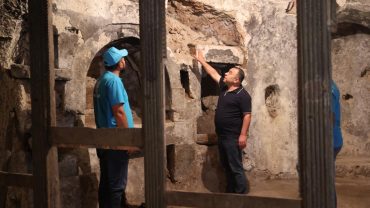Pamukkale day tour is more than just a sightseeing activity — it’s a full-sensory journey through one of Turkey’s most extraordinary natural and archaeological wonders. With its glowing white terraces, healing thermal waters, and ruins of the once-prosperous city of Hierapolis, Pamukkale offers a perfectly balanced day of history, nature, relaxation, and culture. Whether you’re arriving from nearby Denizli or embarking from far-off Cappadocia, a day in Pamukkale leaves a lasting impression on every traveler who sets foot on its surreal landscape.
The Formation of the Travertines – Nature’s Masterpiece
Pamukkale, which translates as “cotton castle,” is famous for its snow-white travertine terraces cascading down the hillside like frozen waterfalls. These formations didn’t happen overnight. Rather, they are the result of thousands of years of geothermal activity. Calcium-rich spring water flows down the slope, depositing thick layers of white calcite as it cools. As a result, this creates the distinctive basin formations that Pamukkale is known for.
During your Pamukkale day tour, you’ll get to walk barefoot across these soft terraces. Moreover, the sensation of warm water underfoot, surrounded by shimmering white mineral shelves, is unlike any spa in the world.
These formations are still active today. New terraces continue to form slowly as the spring water flows. Consequently, Pamukkale remains a dynamic landscape, not a static monument. Because it is part of a UNESCO World Heritage Site, strict rules are in place to protect it: shoes are not allowed on the travertines, and swimming is restricted to designated areas to prevent erosion and discoloration.
The Thermal Waters – Ancient Spa Culture Reborn
The water that flows through Pamukkale’s terraces originates from natural hot springs, which maintain an average temperature of 35°C–38°C (95°F–100°F). These waters are loaded with calcium bicarbonate and other minerals believed to have healing properties. In Roman times, emperors, generals, and aristocrats visited these springs, believing in their rejuvenating powers.
Today, modern visitors on a Pamukkale day tour can enjoy a similar spa-like experience. Whether you choose to dip your feet in the travertine pools or indulge in Cleopatra’s Pool, the soothing qualities of the thermal waters are undeniable. Furthermore, many visitors report improved circulation, reduced stress, and a sense of deep calm.
The Ancient City of Hierapolis – Where Myth Meets Ruin
At the top of the white cliffs lies Hierapolis, an ancient Greco-Roman city that flourished during the 2nd and 3rd centuries AD. Initially founded as a thermal spa town, Hierapolis was built by the kings of Pergamon and later became a prominent city under Roman rule.
Your Pamukkale day tour wouldn’t be complete without exploring its many historic sites:
-
The Theater: A massive, remarkably preserved Roman theater that once held 12,000 spectators. Today, you can still sit on the stone benches and take in the panoramic view of the valley.
-
The Necropolis: One of the largest ancient cemeteries in Turkey, with over 1,200 sarcophagi and tombs.
-
The Martyrium of St. Philip: A religious site believed to be where the apostle Philip was martyred.
-
Ancient Baths and Temples: Including the Frontinus Gate, the agora, and various sacred sites that reflect both pagan and early Christian influence.
Overall, walking through Hierapolis feels like stepping into a living museum. The paths are lined with olive trees, marble columns, and architectural fragments that whisper stories of an empire long gone.
Cleopatra’s Pool – Swim Through History
Also known as the Antique Pool, this warm-water spring is unlike any other in the world. According to legend, Cleopatra herself swam here as a gift from Mark Antony. The pool is filled with submerged ancient columns and marble ruins from the collapse of surrounding Roman structures during an earthquake.
Swimming here is an optional part of many Pamukkale day tour packages. Nevertheless, it is highly recommended. Floating in crystal-clear, mineral-rich water while brushing past actual Roman artifacts is a surreal experience that blends indulgence with ancient wonder.
In addition to the unique atmosphere, facilities around the pool include changing rooms, lockers, a café, and shaded relaxation areas, making it a convenient and enjoyable stop on your tour.
How to Organize Your Pamukkale Day Tour
There are several ways to enjoy Pamukkale depending on where you’re traveling from. Fortunately, tours are available from all major tourist hubs in western Turkey.
🔹 From Denizli:
This is the nearest city, located just 20 minutes away. It is ideal for self-guided visits or locally arranged private tours.
🔹 From Kuşadası or Ephesus:
Tours from these coastal towns typically include Hierapolis, the travertines, and a local lunch. Additionally, return transportation is provided, making it a comfortable day trip.
What Most Tours Include
Most full-day tours offer:
-
Hotel pick-up & drop-off
-
Licensed English-speaking guide
-
Entrance fees to Pamukkale & Hierapolis
-
Optional Cleopatra’s Pool entry
-
Buffet lunch at a traditional Turkish restaurant
As a result, even a short visit becomes a well-organized and memorable adventure.
Book Your Pamukkale Day Tour Now
UNESCO World Heritage – Pamukkale & Hierapolis
This official listing provides further insights into Pamukkale’s universal value and ongoing preservation efforts.



Comment (0)